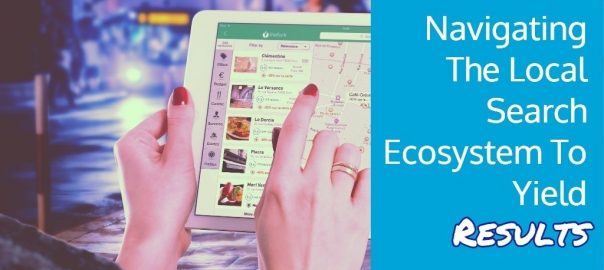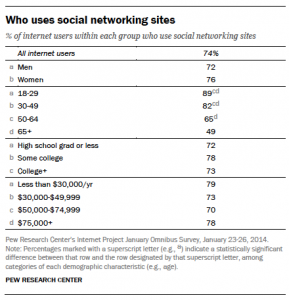The Local Search Ecosystem is made up of many different sources including data aggregators like InfoGroup, review sites like Yelp, social media platforms such as Facebook and Foursquare, geo and vertical directories (think SuperPages, DexKnows, FindLaw), GPS mapping solutions (e.g. Garmin, Here), and of course, search engines like Google and Bing.
Originally the brainchild of David Mihm back in 2009, the Local Search Ecosystem is referenced and admired from far and wide. Not everyone agrees on which sources within the ecosystem have the greatest impact, but we all seem to agree that the Local Search Ecosystem exists. Here is the Local Search Ecosystem just released by Whitespark and Tidings, and here is another Moz released previously. While I haven’t created a graphic to represent Advice Local’s take on the ecosystem, we have our Data Amplifier Network, which is where we distribute business data on the internet.
It’s amazing and can be overwhelming when you really think about how many sources make up the ecosystem, especially when considering all the possible scenarios and strategies there are when it comes to leveraging each source represented in the ecosystem.
Core Components Of The Local Search Ecosystem
No matter whose ecosystem you are looking at, there is no denying that local listings on Google and Bing, the data aggregators, directories and map listings are at the very core.
Today, I’d like to take a look at a few of the sources within the Local Search Ecosystem, along with how quality and consistency plays an important role. Keep reading to find out how a business can leverage each of these sources to place higher in local search results.
1. Google My Business (GMB)
Maybe you are wondering why I gave Google the first spot in this list. Well, it’s because in terms of search engine use, Google holds the global market share at over 77%. Not only are they the preferred engine by consumers, but they are also the default search on iPhone. (You know, Apple! One of the other behemoths dominating technology today.)
Not only does Google dominate the search engine market share, but they are continually updating, upgrading and tweaking the services available to small business owners. In an earlier article I posed the question, “Is the Google My Business Listing Replacing the Website?”
Today, consumers can call a local business, get directions, send a message (which is a text message, by the way), read a Google Post (which includes a CTA button to learn more, buy, sign up, etc.), or visit the business’ website, all from a Google My Business listing that is delivered through search.
How many businesses do you think are fully leveraging all these features today? I don’t have a stat for you, but I can tell you it’s not very many right now. I did a test and can confirm that out of the 10 Google My Business listings I checked, only two had a Google Post published, and none of them had the message featured turned on. Several didn’t even have the listing connected to the business website.
Go out today, audit the GMB listings you manage, and start leveraging all of these features right away! This is an excellent way to quickly become the consumer choice.
2. Data Aggregators
I can’t say enough about how important it is to have clean, consistent data distributed to the data aggregators. I’m referring to Infogroup, Acxiom, Neustar Localeze and Factual here. Data aggregators distribute business data to directories and publishing outlets such as Apple Maps and Google Maps. For instance, Neustar Localeze distributes data to more than 100 search platforms. Many of these search platforms then distribute that data to GPS mapping solutions, etc.
It’s not necessarily complicated to submit to a data aggregator, but there are fees associated with submitting to the various ones. It’s usually more affordable for most businesses to go to a company that offers submitting to all four as a service.
3. Directories
I could go on and on for hours about how important it is for local businesses to be listed in quality directories. These listings make up a majority of the citations (mentions of a business online) on the web. Many of these listings or citations are created from directories partnering with other sources, like data aggregators, that amplify business data to other sources.
Beyond claiming and submitting to these directories, it’s important for businesses to monitor and maintain each listing. A consistent NAP (name, address, phone number) across the web is essential for local businesses. Consistency indicates trust. Inconsistency does the opposite.
Placeable reported that 73% of consumers lose trust in a brand when a listing shows incorrect data. Monitoring and maintaining this accurate location data across these sources can be very time consuming.
Bad data seeps onto the internet in so many different ways, including directories scraping old data from government websites and other sources. Employees can create bad data, too! For example, this can occur when an employee leaves a business and the business no longer has access to an existing directory listing that was associated only with the employee’s email address. Instead of the business reclaiming the existing listing to make updates, they create a new one. This happens quite often. Another big problem is when a business moves locations. Rather than updating the existing listing to the new address, they will create a new listing for the new location and leave the existing one on the web. This is one of the biggest ways a consumer will quickly lose trust in a brand. The consumer drives to a closed location because the business failed to update their existing listing or remove it.
I recommend a quarterly audit to identify new citations, update incorrect citations that seeped out onto the internet, and optimize any citations that haven’t been previously optimized.
4. GPS Mapping
The majority of new cars today come with a navigation system of some type, whether it’s the manufacturer providing a built in-navigation system or the driver plugging in their smart device and connecting to a display via Apple CarPlay or something similar. Consumers hunger for this convenience. They want to easily get turn-by-turn directions to the places they are going.
Ensuring local business data is correct on these mapping platforms is a must. 67% of consumers report that they lose trust in a business if they get lost en route. However, it’s not super easy for a local business to make it into these GPS mapping platforms and in the correct categories.
My recommendation here is to check the major GPS devices like Garmin, TomTom and Magellan to make sure the business data, including GPS coordinates, is correct. If not, you’ll need to identify the sources of the incorrect data and fix it at the core so it propagates correctly in the future.
You Have Lots Of Work Ahead Of You To Optimize For The Entire Local Search Ecosystem
As you can see above, I have only covered four of the many sources that make up the Local Search Ecosystem. It’s up to you to take the next steps and implement what you’ve learned.
Keep in mind that each time Google updates their algorithm or adds a new feature, you’ll need to be at the top of your game and start learning and leveraging for your clients. With proximity searches getting tighter and tighter, you must use all the features, bells and whistles available to reach consumers in search results.
* Adapted lead image: Public Domain, pixabay.com via getstencil.com
The post Navigating The Local Search Ecosystem To Yield Results appeared first on Search Engine People Blog.
(59)
Report Post








